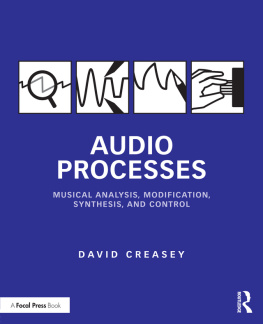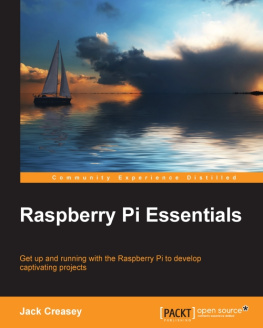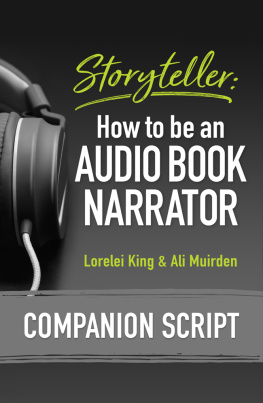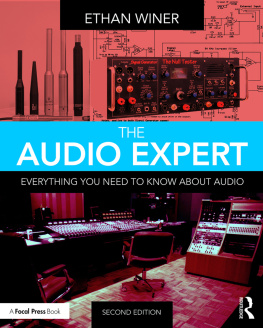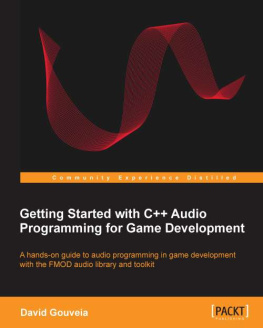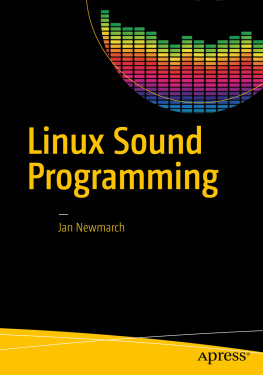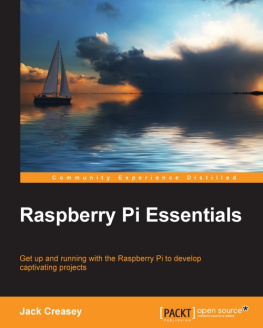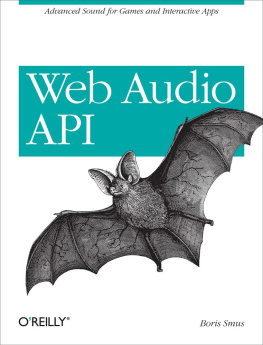Creasey - Audio Processes
Here you can read online Creasey - Audio Processes full text of the book (entire story) in english for free. Download pdf and epub, get meaning, cover and reviews about this ebook. publisher: Taylor and Francis, genre: Computer. Description of the work, (preface) as well as reviews are available. Best literature library LitArk.com created for fans of good reading and offers a wide selection of genres:
Romance novel
Science fiction
Adventure
Detective
Science
History
Home and family
Prose
Art
Politics
Computer
Non-fiction
Religion
Business
Children
Humor
Choose a favorite category and find really read worthwhile books. Enjoy immersion in the world of imagination, feel the emotions of the characters or learn something new for yourself, make an fascinating discovery.
Audio Processes: summary, description and annotation
We offer to read an annotation, description, summary or preface (depends on what the author of the book "Audio Processes" wrote himself). If you haven't found the necessary information about the book — write in the comments, we will try to find it.
Audio Processes — read online for free the complete book (whole text) full work
Below is the text of the book, divided by pages. System saving the place of the last page read, allows you to conveniently read the book "Audio Processes" online for free, without having to search again every time where you left off. Put a bookmark, and you can go to the page where you finished reading at any time.
Font size:
Interval:
Bookmark:

Audio Processes
Musical Analysis, Modification, Synthesis, and Control
David Creasey

First published 2017
by Routledge
711 Third Avenue, New York, NY 10017
and by Routledge
2 Park Square, Milton Park, Abingdon, Oxon OX14 4RN
Routledge is an imprint of the Taylor & Francis Group, an informa business
2017 Taylor & Francis
The right of David Creasey to be identified as author of this work has been asserted by him in accordance with sections 77 and 78 of the Copyright, Designs and Patents Act 1988.
All rights reserved. No part of this book may be reprinted or reproduced or utilised in any form or by any electronic, mechanical, or other means, now known or hereafter invented, including photocopying and recording, or in any information storage or retrieval system, without permission in writing from the publishers.
Trademark notice : Product or corporate names may be trademarks or registered trademarks, and are used only for identification and explanation without intent to infringe.
Library of Congress Cataloging in Publication Data
Names: Creasey, D. P. (David P.), author.
Title: Audio processes: musical analysis, modification, synthesis, and control /
David Creasey.
Description: New York; London: Routledge, 2017. | 2017
Identifiers: LCCN 2016012376 | ISBN 9781138100138 (hardback) |
ISBN 9781138100114 (paperback) | ISBN 9781315657813 (ebook)
Subjects: LCSH: Computer sound processing. | MusicComputer programs.
Classification: LCC MT723 .C72 2017 | DDC 786.7dc23
LC record available at http://lccn.loc.gov/2016012376
ISBN: 978-1-138-10013-8 (hbk)
ISBN: 978-1-138-10011-4 (pbk)
ISBN: 978-1-315-65781-3 (ebk)
Typeset in URW Palladio L by the author
- AD Attack-Decay
- ADC Analogue-to-Digital Converter
- ADR Attack-Decay-Release
- ADSR Attack-Decay-Sustain-Release
- AHDSR Attack-Hold-Decay-Sustain-Release
- AM Amplitude Modulation
- AR Attack-Release
- ASR Attack-Sustain-Release
- BPF Bandpass Filter
- BPM Beats Per Minute
- BRF Bandreject Filter
- DAC Digital-to-Analogue Converter
- DAW Digital Audio Workstation
- DC Direct Current (0Hz)
- DFT Discrete Fourier Transform
- EG Envelope Generator
- EQ Equaliser/Equalisation
- FDN Feedback Delay Network
- FFT Fast Fourier Transform
- FTR Finite Impulse Response
- FM Frequency Modulation
- HPF Highpass Filter
- HF High Frequency
- HMF High-Mid Frequency
- IFFT Inverse Fast Fourier Transform
- IIR Infinite Impulse Response
- LF Low Frequency
- LMF Low-Mid Frequency
- LPF Lowpass Filter
- MF Mid-range Frequency
- MIDI Musical Instrument Digital Interface
- PWM Pulse-Width Modulation
- RMS Root Mean Square
- SPL Sound Pressure Level
- STFT Short Time Fourier Transform
Digital audio processes are algorithmic forms that generate, modify, and analyse audio data. They dominate the landscape of audio recording and production, deeply affecting the way in which music is originated, performed, edited, and consumed. Audio processes enable the exploration of obscure hidden features within sounds, the radical transformation of tonality, the generation of instrument sounds with wild new characteristics, and the potential to all be controlled with natural and expressive human gestures. They also allow great subtlety and precision; slightly changing individual frequencies and amplitudes, accurately synthesising the character of acoustic instruments, and gently massaging a track to fit better in a mix.
The potential is vast, but the basic principles of audio processes are within the grasp of novices and enthusiasts. This is aided by the fact that the quantity of key element types is relatively modest. illustrates the most common process elements that appear in this book. Audio processes are often based on simple forms that are gradually expanded into larger structures. Where the expansion ends depends on the complexity that is desired and how much computational power is available. But even simple forms can have sufficient capacity to provide hours of pleasure. A simple monophonic synthesizer, a distortion effect, and some imagination is sufficient for creating superb musical results.
Exploring the potential of audio processes can take a lifetime. Not only is there the opportunity to build bigger and bigger structures, but also the depth to dig down to the underlying construction of elements and their relationship to the way in which humans perceive sound. This book covers a wide range of topics and provides many routes to explore the world of audio analysis, modification, synthesis, and control. All of them build from decades of work by dedicated individuals, and there are a huge number of books, journal papers, and other sources of information for those who want to learn more. The journey starts here.
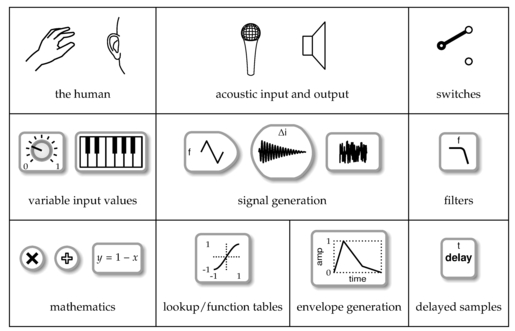
Common process elements
This book is about the practical design of audio processes for musical applications. Computer software for making and recording music is the main application being considered, but the principles are also applicable to other situations. This is not a book that teaches programming nor how to use commercial effects and synthesizers; there are many other books in those areas. Rather, the information here is about the insides of audio processes; understanding how they work, and creating new designs.
This book can be read in different ways depending on prior understanding and the topics of interest. For someone who is new to audio processes and needs a comprehensive grounding in the subject, such as an undergraduate university student, the expectation is that it will be read from the start to the end. The chapters of this book are ordered to aid in the progressive accumulation of understanding. The early chapters introduce fundamental ideas and processes, which later chapters build into more complex arrangements. Care has been taken in sequencing the topics to reduce the need to understand everything at once.
Those with prior experience might choose to read individual chapters, as efforts have been made to contain related methods together, rather than spreading them across the book. Inevitably there are many overlaps between techniques, however, and it is often possible to combine approaches to achieve more sophisticated results. Cross-references are provided where possible to direct the reader to related chapters and methods, rather than repeating basic ideas in every chapter. Notations specific to particular programming languages are avoided where possible.
The aim of the book is to explain the key techniques for each topic. From the fundamentals it is usually possible to achieve sophistication by expanding and combining ideas. Although it is not always the case, a simple process with a small number of elements will tend to produce an unsophisticated result. Professional systems build on basic ideas to create more naturalistic, tonally-interesting or target-specific results.
Font size:
Interval:
Bookmark:
Similar books «Audio Processes»
Look at similar books to Audio Processes. We have selected literature similar in name and meaning in the hope of providing readers with more options to find new, interesting, not yet read works.
Discussion, reviews of the book Audio Processes and just readers' own opinions. Leave your comments, write what you think about the work, its meaning or the main characters. Specify what exactly you liked and what you didn't like, and why you think so.

